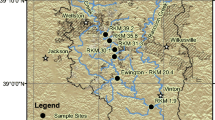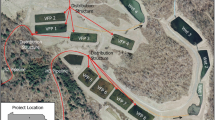Abstract
A variety of passive and semi-passive treatment systems were constructed by state and local agencies to neutralize acidic mine drainage (AMD) and reduce the transport of dissolved metals in the upper Swatara Creek Basin in the Southern Anthracite Coalfield in eastern Pennsylvania. To evaluate the effectiveness of selected treatment systems installed during 1995–2001, the US Geological Survey collected water-quality data at upstream and downstream locations relative to each system eight or more times annually for a minimum of 3 years at each site during 1996–2007. Performance was normalized among treatment types by dividing the acid load removed by the size of the treatment system. For the limestone sand, open limestone channel, oxic limestone drain, anoxic limestone drain (ALD), and limestone diversion well treatment systems, the size was indicated by the total mass of limestone; for the aerobic wetland systems, the size was indicated by the total surface area of ponds and wetlands. Additionally, the approximate cost per tonne of acid treated over an assumed service life of 20 years was computed. On the basis of these performance metrics, the limestone sand, ALD, oxic limestone drain, and limestone diversion wells had similar ranges of acid-removal efficiency and cost efficiency. However, the open limestone channel had lower removal efficiency and higher cost per ton of acid treated. The wetlands effectively attenuated metals transport but were relatively expensive considering metrics that evaluated acid removal and cost efficiency. Although the water-quality data indicated that all treatments reduced the acidity load from AMD, the ALD was most effective at producing near-neutral pH and attenuating acidity and dissolved metals. The diversion wells were effective at removing acidity and increasing pH of downstream water and exhibited unique potential to treat moderate to high flows associated with storm flow conditions.






Similar content being viewed by others
References
American Public Health Association (1998a) Alkalinity (2320)/Titration method. In: Clesceri LS, Greenberg AE, Eaton AD (eds) Standard methods for the examination of water and wastewater, 20th edn. American Public Health Association, Washington, DC, pp 2.26–2.30
American Public Health Association (1998b) Acidity (2310)/Titration method. In: Clesceri LS, Greenberg AE, Eaton AD (eds) Standard methods for the examination of water and wastewater, 20th edn. American Public Health Association, Washington, DC, pp 2.24–2.26
Arnold DE (1991) Diversion wells—a low-cost approach to treatment of acid mine drainage. Proceedings of 12th Annual West Virginia surface mine drainage task force symposium, WV Mining and Reclamation Association, Charleston, WV, USA, pp 39–50
Commonwealth of Pennsylvania (2002) Water quality standards. Ch 93. PA Code, Title 25. Environmental Protection, Harrisburg, pp 93.1–93.226
Cravotta CA III (2003) Size and performance of anoxic limestone drains to neutralize acidic mine drainage. J Environ Qual 32:1277–1289
Cravotta CA III (2007) Passive aerobic treatment of net-alkaline, iron-laden drainage from a flooded underground anthracite mine, Pennsylvania, USA. Mine Water Environ 26:128–149
Cravotta CA III (2008a) Dissolved metals and associated constituents in abandoned coal-mine discharges, Pennsylvania, USA: 2. Geochemical controls on constituent concentrations. Appl Geochem 23:203–226
Cravotta CA III (2008b) Laboratory and field evaluation of a flushable oxic limestone drain for treatment of net-acidic, metal-laden drainage from a flooded anthracite mine, Pennsylvania, USA. Appl Geochem 23:3404–3422
Cravotta CA III, Bilger MD (2001) Water-quality trends for a stream draining the Southern Anthracite Field, Pennsylvania. Geochem Explor Environ Anal 1:33–50
Cravotta CA III, Trahan MK (1999) Limestone drains to increase pH and remove dissolved metals from acidic mine drainage. Appl Geochem 14:581–606
Cravotta CA III, Weitzel JB (2001) Detecting change in water quality from implementation of limestone treatment systems in a coal-mined watershed, Pennsylvania. Proceedings of 8th national nonpoint source monitoring program workshop. USEPA Seminar Series EPA/905-R-01-008
Cravotta CA III, Ward SJ, Koury DJ, Koch RD (2004) Optimization of limestone drains for long-term treatment of acidic mine drainage, Swatara Creek Basin, Schuylkill County, PA. Proceedings of 2004 national meeting of the American society of mining and reclamation and 25th WV Surface Mine Drainage Task Force, pp 366–411
Cravotta CA III, Brightbill RA, Langland MJ (2010) Abandoned mine drainage in the Swatara Creek Basin, Southern Anthracite Coalfield, Pennsylvania, USA: 1. Stream water quality trends coinciding with the return of fish. Mine Water Environ. doi:10.1007/s10230-010-0112-6
Growitz DJ, Reed LA, Beard MM (1985) Reconnaissance of mine drainage in the coal fields of eastern Pennsylvanian. US Geol Surv WRI 83-4274, 54 pp
Hedin RS, Nairn RW, Kleinmann RLP (1994a) Passive treatment of coal mine drainage. USBM IC 9389, US Bureau of Mines, Pittsburgh, p 35
Hedin RS, Watzlaf GR, Nairn RW (1994b) Passive treatment of acid mine drainage with limestone. J Environ Qual 23:1338–1345
Helsel DR, Hirsch RM (2002) Statistical methods in water resources. US Geol Surv Techniques of Water-Resources Investigations 04-A3, 523 pp
Kirby CS, Cravotta CA III (2005) Net alkalinity and net acidity 2: practical considerations. Appl Geochem 20:1941–1964
Koury DJ, Hellier WW (1999) Constructed wetland for mine drainage treatment Lorberry Junction wetland project. National Association Abandoned Mine Lands Programs Conf Pennsylvania, 9 pp
Raymond PA, Oh N-H (2009) Long-term changes of chemical weathering in rivers heavily impacted from acid mine drainage: insights on the impact of coal mining on regional and global carbon and sulfur budgets. Earth Planet Sci Let 284:50–56
Skousen JG, Rose AW, Geidel G, Foreman J, Evans R, Hellier W (1998) Handbook of technologies for avoidance and remediation of acid mine drainage. National Mine Land Reclamation Center, Morgantown, p 131
Watzlaf GR, Schroeder KT, Kleinmann RLP, Kairies CL, Nairn RW (2004) The passive treatment of coal mine drainage. US DOE/NETL-2004/1202, 72 pp
Wood CR (1996) Water quality of large discharges from mines in the anthracite region of eastern Pennsylvania. US Geol Surv Water-Resour Inv Rep 95-4243, 69 pp
Ziemkiewicz PF, Skousen JG, Brant DL, Sterner PL, Lovett RJ (1997) Acid mine drainage treatment with armored limestone in open limestone channels. J Environ Qual 26:1017–1024
Ziemkiewicz PF, Skousen JG, Simmons J (2003) Long-term performance of passive acid mine drainage treatment systems. Mine Water Environ 22:118–129
Acknowledgments
This research was supported by the PaDEP and the Schuylkill Conservation District with funding from the USEPA Nonpoint Point Source National Monitoring Program, the USDOE, and the USGS Cooperative Water-Resources Program. The author is grateful to Roger J. Hornberger and Daniel J. Koury of PaDEP for their sustained support. Jeffrey J. Chaplin, Emily Eggler, Katherine Tuers Brayton, Suzanne J. Ward, Jeffrey B. Weitzel, and Kovaldas “KB” Balciauskas presently or formerly at USGS, are acknowledged for critical assistance with field work and data processing. Helpful reviews of early drafts of the manuscript were provided by Michael J. Langland, Ralph J. Haefner, J. Kent Crawford, and Kevin J. Breen of USGS, and Christopher H. Gammons of Montana Tech, and an anonymous reviewer. Any use of trade, firm, or product names is for descriptive purposes only and does not imply endorsement by the U.S. Government.
Author information
Authors and Affiliations
Corresponding author
Electronic supplementary material
Below is the link to the electronic supplementary material.
Figure A1
Water-quality data upstream (C4) and downstream (C6) of treatment with limestone sand in Coal Run (LSC). Vertical dashed line indicates implementation date of treatment. Access road was restricted from December 1997 to March 1999; upstream data were not collected after September 2000 (PDF 67 kb)
Figure A2
Water-quality data upstream (B1) and downstream (B3) of treatment with open limestone channel on Swatara Creek (OLC). Vertical dashed line indicates implementation date of treatment. Upstream data were not collected after September 2000 (PDF 82 kb)
Figure A3
Water-quality data upstream (H0) and downstream (H1) of treatment with oxic limestone drain (OLD) at Hegins discharge (ODH). Vertical dashed line indicates implementation date of treatment. After initial implementation, limestone was added in September 2005 (dash-dot line) (PDF 84 kb)
Figure A4
Water-quality data upstream (A1) and downstream (A2, A3) of treatment with anoxic limestone drain (ALD) at Buck Mountain discharge (ADB). Vertical dashed line indicates implementation date of treatment. After initial implementation, limestone was added in January 2001 and September 2005 (dash-dot line) (PDF 115 kb)
Figure A5
Water-quality data upstream (C1) and downstream (C3) of treatment with limestone diversion wells on Swatara Creek (DWS) near Newtown. Vertical dashed line indicates implementation date of treatment (PDF 96 kb)
Figure A6
Water-quality data upstream (E2-0) and downstream (E2-1) of treatment with limestone diversion wells on Lorberry Creek (WLL) below the Rowe Tunnel discharge. Vertical dashed line indicates implementation date of treatment (PDF 88 kb)
Figure A7
Water-quality data upstream (E2-1A) and downstream (E2-2) of treatment with aerobic wetlands on Lorberry Creek (WLL) below the diversion wells. Vertical dashed line indicates implementation date of treatment (PDF 75 kb)
Figure A8
Water-quality data upstream (E3-1) and downstream (E3-2) of treatment with limestone- compost wetlands on Lower Rausch Creek (WLR). Vertical dashed line indicates implementation date of treatment (PDF 87 kb)
Rights and permissions
About this article
Cite this article
Cravotta, C.A. Abandoned Mine Drainage in the Swatara Creek Basin, Southern Anthracite Coalfield, Pennsylvania, USA: 2. Performance of Treatment Systems. Mine Water Environ 29, 200–216 (2010). https://doi.org/10.1007/s10230-010-0113-5
Received:
Accepted:
Published:
Issue Date:
DOI: https://doi.org/10.1007/s10230-010-0113-5




